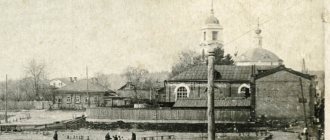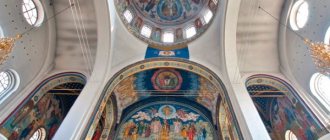The Holy Dormition Cathedral (also known as the Cathedral of the Dormition of the Blessed Virgin Mary) is the main religious attraction of Smolensk, located in its center, on Cathedral Hill, offering panoramic views of the city. The cathedral is a cultural heritage site of federal significance.
The Assumption Cathedral was built in 1677 on the site of the 12th century cathedral of the same name.
The height of the Holy Assumption Cathedral is 69 meters.
The architectural ensemble also includes a bell tower, chambers and carriage buildings.
The cathedral itself is made in the Baroque style; inside there is an iconostasis more than 30 meters high.
© ted
History of construction
Smolensk City Cathedral is one of the most famous and majestic churches in Russia. Its building towers above all city buildings. The appearance of the temple became possible thanks to Vladimir Monomakh, who laid its foundation at the beginning of the 12th century (1101). This is confirmed in the Hypatia Chronicle.
Assumption Cathedral in Smolensk
Monomakh oversaw the construction of the central city cathedral. At that time, stone churches were rare in the Smolensk principality. The prince donated to the newly built cathedral the image of the Mother of God, passed down in his family from generation to generation and glorified by miracles - the “Hodegetrya” icon. This event had enormous political significance, turning Smolensk into the capital city of the principality. In 1150, the consecration of the Assumption Church was celebrated.
Excursion into history
The first cathedral was founded at the beginning of the 12th century (1101) by Prince Monomakh, giving rise to the construction of stone churches in Smolensk. Over the next five centuries, the cathedral was the main religious and architectural dominant of the city, but it was not destined to survive to this day.
In 1609, at the height of the Time of Troubles, the city was besieged by the Poles. The siege lasted for 20 long months, but Smolensk successfully defended itself, despite the lack of food and water, as well as the widespread disease among local residents. In June 1611, the enemy burst into the city, breaking through a weak section of the eastern wall of the fortress following a tip from one of the local residents, assistant architect of the Smolensk fortress Andrei Dedeshin.
Assumption Cathedral. Photo: goldenmiddle.ru
The Poles blew up the cellars with reserves of gunpowder located in the thickness of the Sbornaya Gora (according to other historical sources, the gunpowder was stored in the temple itself), and the upper tier of the cathedral collapsed, burying the townspeople and defenders of Smolensk who were hiding from the enemy under its ruins. Subsequently, the Poles constructed a wooden ceiling over the ruins and converted the temple into a church.
After the liberation of the city, they decided not to restore the temple, but to build a new one in its place. In the second 1674-1675 the cathedral was dismantled to its foundations. In 1676, a plan for the construction of a new Assumption Cathedral was approved. Soon the Moscow architect A. Korolkov arrived in the city. Construction work began in 1976. In 1728, according to some sources, the place of chief architect was taken by Anton Schedel, the son of the Russified German Johann Schedel, the author of the Menshikov palaces in St. Petersburg and Oranienbaum. According to other sources, the architect was still Schedel the elder. It was with the arrival of a master of German origin that the temple under construction acquired the features of Western Baroque. The cathedral was consecrated in 1740, but actual construction work continued over the next three decades.
Interior design. Photo: smoldigest.ru
Literally in the first few years after the completion of the construction of the cathedral, dangerous cracks began to appear in its vaults and domes, threatening the integrity of the entire structure. Soon the planked wooden roof was replaced with a tin one. By 1750 the dome had collapsed. The domes of the temple were rebuilt according to the design of the architect Pyotr Obukhov: the large dome from stone became wooden, and instead of seven domes, five were built in the traditions of Russian architecture. Also, a bell tower and a warm Epiphany Cathedral were soon added. Major repairs were carried out with private donations from citizens and patrons of the arts.
It seems incredible, but the Smolensk Cathedral survived the Russian-French War of 1812, and the bloody revolutionary years, and even the Great Patriotic War. By personal order of Napoleon, who was amazed by the beauty of the shrine, 24-hour security was provided to the temple. In the post-revolutionary period, the Museum of Atheism was opened in the Assumption Cathedral, which also saved it from demolition. In 1941, during the German occupation of the city, the temple was again heavily guarded by order of General Guderian.
Architecture and decoration of the temple
The temple building was thoroughly destroyed by the explosion, but still remained a pearl of architectural architecture. The Poles used the dilapidated cathedral for their liturgical needs and built a church in it. Even though the temple at the top was seriously damaged, they covered the roof with boards.
On the site of the war-damaged cathedral, another, renovated temple was subsequently erected. Its architectural features:
- cross-domed;
- cubic;
- with a three-part apse;
- with three entrance portals.
The decoration of the cathedral is the iconostasis, covered with gilding, made of linden wood and is a masterpiece of decorative and applied art. Its painting was attended by masters whose art was formed under the influence of the school of Andrei Rublev.
Interior of the Assumption Cathedral
The cathedral is very spacious inside, it has about two thousand meters. Inside the height reaches about thirty meters, outside - more than seventy meters. The construction of the cathedral was completed by 1772, and since that time there have been no changes in the appearance of the building.
At the end of the 18th century, a room for the city clock was built near the temple, as well as a bell tower, which housed three bells:
- festive;
- all-merciful;
- everyday.
It is from here that the bells begin to ring over the city. The current ensemble of the cathedral hill is:
- the cathedral itself;
- Church of John the Baptist;
- Church of the Annunciation;
- bishops' and former living chambers.
A large wide staircase leads up the hill to the cathedral, emphasizing the majesty of the place, which has been the heart of the Smolensk land for thousands of years.
Smolensk often suffered from various wars, but the rare and majestic beauty of the temple conquered even the hearts of the invaders. There is historical evidence that Napoleon himself bowed his naked head in front of the temple building when he led his troops to Moscow. And Colonel General Guderian, who led the German tank forces in 1941, issued an order to take good care of the cathedral building.
Soviet artillery troops were also forbidden to use the temple as a landmark during shelling of the occupied city. During Soviet times, an anti-religious museum was located within the walls of the cathedral.
Important! The shrine truly came to life when the Smolensk See was headed by the current Patriarch of Moscow and All Rus' Kirill, who spent 25 years of his episcopal service here. Every day hundreds of people come here to pray in order to feel the extraordinary atmosphere that reigns here on the cathedral hill.
Activities of the parish
Extensive educational activities are carried out on the territory of the cathedral. Anyone can attend educational lectures held as part of:
- Sunday school for adults. Fri., 18-00 and Sun., 12-00, in the throne room of the diocesan administration;
- youth discussion club "Theologian". Mon., 19-00, in the administrative building of the Assumption Cathedral;
- cadet class "Khutor Rai".
Divine service in the Assumption Cathedral
Sunday school conducts classes on the study of the Holy Scriptures, theological works, and choir singing.
Icons of the Assumption Cathedral in Smolensk
The Smolensk Holy Assumption Cathedral houses several Orthodox shrines, including the icon of St. Seraphim of Sarov and the image of the Mother of God Hodegetria (“Guide”), which according to legend was painted by the holy evangelist Luke.
Among other shrines, it is worth noting the iron sandals of the patron saint of Smolensk, Saint Mercury, who is revered among the martyrs. He defended Smolensk from the attack of Batu Khan in 1239, accepting martyrdom. His body was buried in the Assumption Cathedral.
The skillfully made five-tiered iconostasis, more than 30 meters high, presumably dates back to the 1730s-40s.
© Konstantin Viktorovich
Schedule of services and patronal holidays
The schedule of services in the Cathedral of the city of Smolensk in general terms looks something like this:
| Mon. | 9-00 18-00 | Liturgy Vespers |
| Tue | 9-00 18-00 | Liturgy Vespers Prayer service with akathist to the Smolensk Icon of the Mother of God “Hodegetria” |
| Wed. | 9-00 18-00 | Liturgy Vespers |
| Thurs. | 9-00 18-00 | Liturgy Vespers Prayer service with akathist to St. Nicholas the Wonderworker or St. Seraphim of Sarov (alternately, every other week) |
| Fri. | 9-00 18-00 | Liturgy Vespers |
| Sat. | 9-00 18-00 | Liturgy All-night vigil |
| Sun. | 7-00 10-00 18-00 | Early liturgy Late Liturgy Vespers Prayer service with akathist to the Sweetest Jesus or the Kazan Icon of the Mother of God (alternately, every other week) |
Attention! Patronal celebrations take place in the cathedral several times a year. One of them, August 10, is celebrated in honor of the Smolensk icon of the Mother of God “Hodegetria”. Festive celebrations take place on August 28 - the day of remembrance of the Dormition of the Blessed Virgin Mary.
History of the Assumption Cathedral
The original cathedral was founded back in 1101 by Prince Vladimir Vsevolodovich Monomakh, who ordered the foundation of the stone Cathedral of the Assumption of the Blessed Virgin Mary on this site (simultaneously with the foundation of the cathedral of the same name in Suzdal).
This stone cathedral remained the only stone church building in the city for almost half a century. After the consecration of the cathedral, Vladimir Monomakh moved into it the icon of the Mother of God Hodegetria, which he inherited from his parents.
In 1127, with the coming to power of the grandson of Vladimir Monomakh, Prince Rostislav Mstislavovich, the Smolensk principality began to flourish, and in 1136–1137 a special Smolensk diocese of the Russian Orthodox Church was established, and the Assumption Cathedral (finally completed by that time) became the main cathedral.
© Smol City
The tragic event of the destruction of the Assumption Cathedral occurred in 1611 - then the stocks of explosives that were stored next to the cathedral hill were blown up. As a result of the explosion, part of the cathedral also collapsed.
In 1674–75, after the liberation of Smolensk from the Polish-Lithuanian occupation, the old building of the Assumption Cathedral was finally dismantled. Two years later, it was decided to build a new cathedral building, increasing its size. The architect was Alexey Korolkov. But he was unable to complete the construction, work was suspended until 1712. The temple was finally completed only in 1740 and had 7 domes. 20 years later, two chapters collapsed. The temple was rebuilt by the architect Obukhov, who gave the cathedral a traditional look with 5 domes.
The cathedral was practically not damaged during the Patriotic War of 1812. The French Emperor Napoleon was amazed by the beauty of the cathedral and ordered its protection.
The cathedral also survived the Nazi occupation. Then the prototype of the Smolensk Icon of the Mother of God disappeared from it, the building itself remained unharmed.
During the period of Soviet power, during times of religious persecution, the church housed an anti-religious museum.
Eventually the Assumption Cathedral was given back to the Russian Orthodox Church, and is now one of the city's main tourist attractions.
© Andrey Popov











